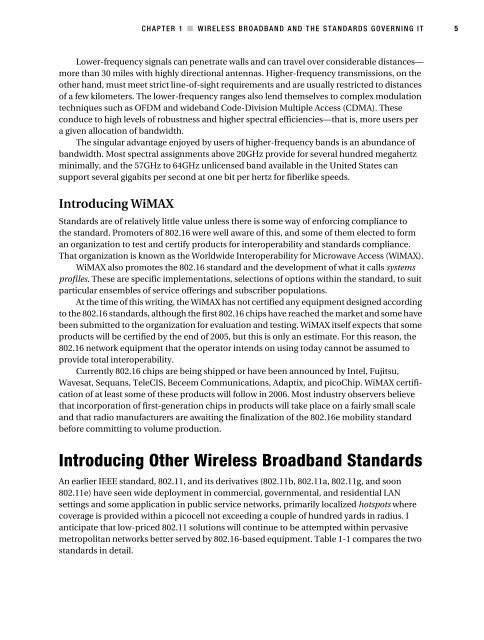WiMax Operator's Manual
WiMax Operator's Manual
WiMax Operator's Manual
You also want an ePaper? Increase the reach of your titles
YUMPU automatically turns print PDFs into web optimized ePapers that Google loves.
CHAPTER 1 ■ WIRELESS BROADBAND AND THE STANDARDS GOVERNING IT 5<br />
Lower-frequency signals can penetrate walls and can travel over considerable distances—<br />
more than 30 miles with highly directional antennas. Higher-frequency transmissions, on the<br />
other hand, must meet strict line-of-sight requirements and are usually restricted to distances<br />
of a few kilometers. The lower-frequency ranges also lend themselves to complex modulation<br />
techniques such as OFDM and wideband Code-Division Multiple Access (CDMA). These<br />
conduce to high levels of robustness and higher spectral efficiencies—that is, more users per<br />
a given allocation of bandwidth.<br />
The singular advantage enjoyed by users of higher-frequency bands is an abundance of<br />
bandwidth. Most spectral assignments above 20GHz provide for several hundred megahertz<br />
minimally, and the 57GHz to 64GHz unlicensed band available in the United States can<br />
support several gigabits per second at one bit per hertz for fiberlike speeds.<br />
Introducing WiMAX<br />
Standards are of relatively little value unless there is some way of enforcing compliance to<br />
the standard. Promoters of 802.16 were well aware of this, and some of them elected to form<br />
an organization to test and certify products for interoperability and standards compliance.<br />
That organization is known as the Worldwide Interoperability for Microwave Access (WiMAX).<br />
WiMAX also promotes the 802.16 standard and the development of what it calls systems<br />
profiles. These are specific implementations, selections of options within the standard, to suit<br />
particular ensembles of service offerings and subscriber populations.<br />
At the time of this writing, the WiMAX has not certified any equipment designed according<br />
to the 802.16 standards, although the first 802.16 chips have reached the market and some have<br />
been submitted to the organization for evaluation and testing. WiMAX itself expects that some<br />
products will be certified by the end of 2005, but this is only an estimate. For this reason, the<br />
802.16 network equipment that the operator intends on using today cannot be assumed to<br />
provide total interoperability.<br />
Currently 802.16 chips are being shipped or have been announced by Intel, Fujitsu,<br />
Wavesat, Sequans, TeleCIS, Beceem Communications, Adaptix, and picoChip. WiMAX certification<br />
of at least some of these products will follow in 2006. Most industry observers believe<br />
that incorporation of first-generation chips in products will take place on a fairly small scale<br />
and that radio manufacturers are awaiting the finalization of the 802.16e mobility standard<br />
before committing to volume production.<br />
Introducing Other Wireless Broadband Standards<br />
An earlier IEEE standard, 802.11, and its derivatives (802.11b, 802.11a, 802.11g, and soon<br />
802.11e) have seen wide deployment in commercial, governmental, and residential LAN<br />
settings and some application in public service networks, primarily localized hotspots where<br />
coverage is provided within a picocell not exceeding a couple of hundred yards in radius. I<br />
anticipate that low-priced 802.11 solutions will continue to be attempted within pervasive<br />
metropolitan networks better served by 802.16-based equipment. Table 1-1 compares the two<br />
standards in detail.
















